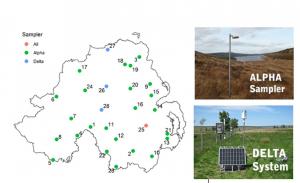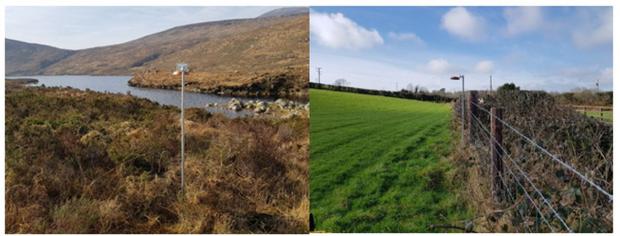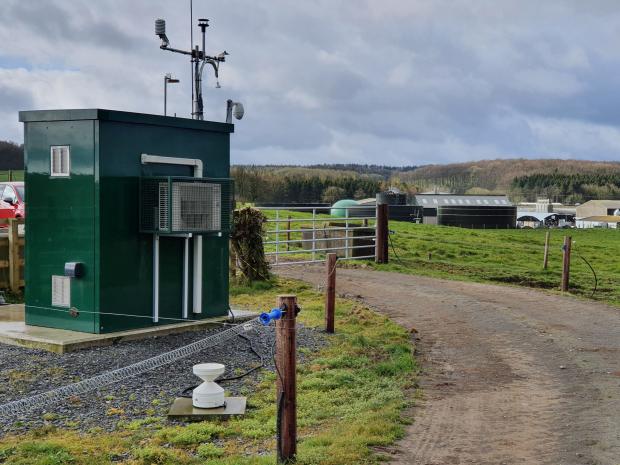Ammonia emissions from livestock present major challenges to the agricultural industry in Northern Ireland. Funded by the Department of Agriculture, Environment and Rural Affairs (DAERA), the Agri-Food and Biosciences Institute (AFBI) is currently conducting a major programme of research and has released this series of articles to help stakeholders understand the issue and adopt the solutions necessary to reduce emissions and increase nitrogen use efficiency.

As discussed previously in this series, it is important that ammonia levels in the air are reduced within Northern Ireland in order to comply with legislation and help protect some of our rarest habitats. To do this effectively, and as part of AFBI’s research in collaboration with the UK Centre for Ecology & Hydrology (UKCEH), monitoring of ammonia concentrations across Northern Ireland has been set up to establish a known baseline. This research includes:
- An extension to the existing National Ammonia Monitoring Network in Northern Ireland (3 sites). 28 monitoring sites are now established to investigate patterns in ammonia concentrations in the air across the province and to more rigorously ground-truth modelled ammonia concentration estimates and provide independent verification of the ammonia concentration modelling approach.
- The establishment of a high-frequency, continuous ammonia monitoring site at AFBI Hillsborough as a case study to determine cause and effect between farm activities and ammonia concentrations in the air.
The extended ammonia monitoring network
Atmospheric ammonia concentrations have been systematically monitored across the UK since 1996 to study differences in ammonia concentrations over space and time.
The DEFRA UK National Ammonia Monitoring Network (NAMN) and Acid Gas and Aerosol Network (AGA-Net) are comprised of 72 and 27 sites respectively across the UK. NAMN sites use passive diffusion ALPHA® samplers while AGA-Net sites use active diffusion DELTA® samplers. Both of these sampler types provide time-averaged monthly ammonia concentration data. Data from the networks are used to ground-truth and calibrate modelled atmospheric ammonia concentrations (e.g. from the FRAME model) from which estimates of nitrogen deposition across the UK are derived.

Northern Ireland has 3 permanent NAMN sites (Hillsborough, Coleraine and Lough Navar) and 2 AGA-Net sites (Hillsborough and Lough Navar). AFBI, in collaboration with the UK Centre for Ecology & Hydrology (UKCEH) have established a new Northern Ireland ammonia monitoring network of 25 new ALPHA® samplers and 4 new DELTA® samplers, which have been measuring atmospheric ammonia concentrations since March 2019 (Fig. 1 and 2).
The new monitoring sites were located to achieve representative coverage geographically and across the range of modelled ammonia concentrations, that is, across locations from areas of high ammonia concentrations to those with background concentrations (i.e. low emission areas). Sites were also required to provide representative coverage of all major agricultural sectors (cattle, pigs, poultry, sheep and mixed farming). Some sites were located close to or within designated nature conservation sites such as Special Areas of Conservation (SAC) or Areas of Special Scientific Interest (ASSI). Some sites were co-located with other existing UK environmental monitoring sites (e.g. COSMOS soil moisture network or UWMN Uplands Water Monitoring Network).
Results from the network over the first 12 months of monitoring suggest that there is good agreement with modelled estimates of atmospheric ammonia across Northern Ireland. These results provide confidence in the ammonia modelling methodology which enables us to predict the emission, dispersion of ammonia and deposition of nitrogen. Having this detailed baseline of ammonia concentrations across the region is also fundamental to estimating with greater confidence the emission reduction potential of ammonia reduction strategies, if these are adopted.
Continuous Ammonia Monitoring
In addition to the extended ammonia monitoring network established in Northern Ireland, AFBI in collaboration with the UK Centre for Ecology & Hydrology (UKCEH) are undertaking a pilot project to illustrate the cause and effect between agricultural activities and atmospheric ammonia concentrations on the AFBI Hillsborough research farm. Using this type of continuous monitoring station to engage with farmers was a key recommendation by the Expert Working Group on ammonia emissions chaired by Dr John Gilliland.

This research is providing a unique and valuable insight which will allow researchers to provide advice on the interactions between local ammonia-generating agricultural activities alongside the impacts of climatic factors and background atmospheric ammonia concentrations. For example, warmer temperatures increase the emission potential from slurries, and ammonia levels build up under calm conditions, whereas the emitted plumes of ammonia are dispersed and diluted in windy conditions.
Additionally, the study will provide real-time atmospheric ammonia data which AFBI and UKCEH scientists will interrogate alongside farm management data. This will allow stakeholders and the wider public to understand the interactions between agricultural activities and environmental conditions, their effect on ammonia concentrations, and to see the beneficial effects of ammonia reduction strategies being adopted on the AFBI Hillsborough farm.
When considering these data it is important to note that the farm at AFBI Hillsborough is large and complex in terms of ammonia sources. It is located over 10km away from the closest designated nature conservation site, so ammonia emissions from the site do not contribute significantly to nitrogen deposition at any protected site. A proportion of ammonia emissions from the farm is deposited to ground on or close to site, with the remainder being transported off site by wind and either deposited on adjacent land, most of which is agricultural or react with other atmospheric components and potentially be transported significant distances.
Preliminary data from the project show a notable annual trend in ammonia concentrations, with increases in spring with the resumption of slurry spreading, peaking in summer and gradually decreasing over late summer and autumn to reach their lowest levels in winter.
Peaks in ammonia are generally associated with local slurry spreading, slurry store mixing, fertiliser spreading and livestock housing. Environmental variables such as wind speed, wind direction and rainfall also have a significant impact on atmospheric ammonia concentrations at the monitoring site, with calm conditions allowing ammonia to accumulate in the vicinity and higher wind conditions dispersing ammonia further afield, leading to lower concentrations at the monitoring site. Similarly, rainfall reduces gaseous atmospheric ammonia concentrations as raindrops intercept ammonia in the atmosphere and deposit it as ammonium in rainwater.
Over the coming weeks, this series of articles focusing on the AFBI research programme to address ammonia emissions in NI will outline the work being undertaken in more detail and the key findings to date. Next week’s article will explore a series of farm-scale ammonia reduction case studies for the dairy and beef sectors, investigating which ammonia reduction measures may be most applicable in these sectors and the potential reduction in farm ammonia and nitrogen savings that could be achieved.
You can view previous articles in the series below:
- Article 1: Tackling Agricultural Ammonia Emissions in Northern Ireland
- Article 2: Reducing Ammonia Emissions across Northern Ireland
- Article 3: The cost of tackling Ammonia Emissions
Notes to editors:
AFBI is an arms-length body of DAERA delivering research and development, diagnostic and analytical testing, emergency response capability and expert scientific advice for DAERA and other government departments, public bodies and commercial companies in Northern Ireland, and further afield.
AFBI’s Vision is “Advancing the Local and Global Agri-Food Sectors Through Scientific Excellence”.
AFBI’s core areas:
- Leading improvements in the agri-food industry;
- Protecting animal, plant and human health;
- Enhancing the natural and marine environment.
Latest news
- AFBI issues Nematodirus warning – Spring 2025 11 April 2025
- Managing Nature Based Risks to the UK Economy and Opportunities for Green Finance 08 April 2025
- AFBI Hillsborough host AERA committee 27 March 2025
- The Omics Days Conference 27 March 2025
